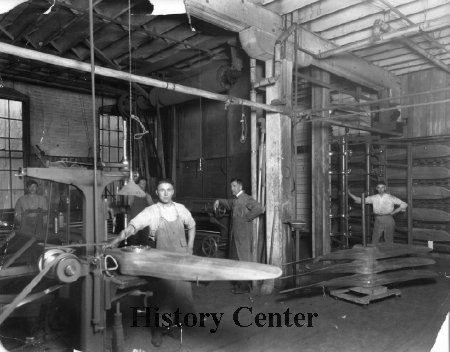Date:
c. 1918
Title:
Packard Propeller
Description:
Following the Declaration of War passed by Congress on 6 April 1917, a surge of patriotism within the city led to the enlistment of 3,000 men from the Fort Wayne Recruiting District, fifty-five percent of the total initial quota for the state of Indiana. Local citizens and a few industries also contributed to the war effort. One of these was the Packard Piano Company.
The Packard Company manufactured airplane propellers for the United States Air Service during World War I at its factory on the northeast corner of Fairfield and Organ Avenues (now Packard Park). The company employed highly-skilled woodworkers in the production of fine pianos. Company officials approached authorities in Washington to inquire about what they could do to contribute to the war effort. Their many years of experience with wood manufacturing and ability to apply those collective talents to a new product convinced the government to award Packard a contract to make 1000 propellers for training aircraft and 1000 for combat planes. Eventually sixty craftsmen were employed in propeller production. The propellers were made from laminated wood (usually mahogany), glued together, then shaped and balanced. The tips of the propeller wings were reinforced with cloth to guard against delaminating at the thin edges. Varnish was then applied, further balancing was done and the propellers were finally in-spected. This training propeller is 110-1/4 inches long and is marked "PLANE DEH 4. STANDING R.P.M. 1470. ENG. U.S. 12. PART NO. 4.P. 688 BA. P. NO.
The Packard Company manufactured airplane propellers for the United States Air Service during World War I at its factory on the northeast corner of Fairfield and Organ Avenues (now Packard Park). The company employed highly-skilled woodworkers in the production of fine pianos. Company officials approached authorities in Washington to inquire about what they could do to contribute to the war effort. Their many years of experience with wood manufacturing and ability to apply those collective talents to a new product convinced the government to award Packard a contract to make 1000 propellers for training aircraft and 1000 for combat planes. Eventually sixty craftsmen were employed in propeller production. The propellers were made from laminated wood (usually mahogany), glued together, then shaped and balanced. The tips of the propeller wings were reinforced with cloth to guard against delaminating at the thin edges. Varnish was then applied, further balancing was done and the propellers were finally in-spected. This training propeller is 110-1/4 inches long and is marked "PLANE DEH 4. STANDING R.P.M. 1470. ENG. U.S. 12. PART NO. 4.P. 688 BA. P. NO.



